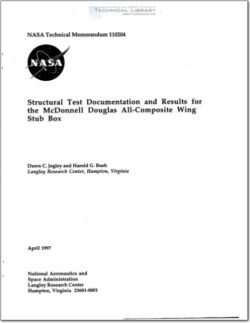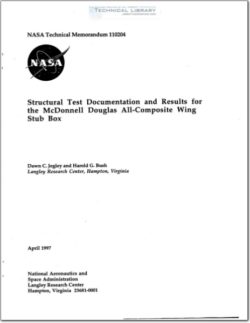NASA-TM-110204

- Version
- 212 Downloads
- 1.50 MB File Size
- 1 File Count
- April 6, 2016 Create Date
- April 6, 2016 Last Updated
Structural Test Documentation and Results for the McDonnell Douglas All-Composite Wing Stub Box

The results of a series of tests conducted at the NASA Langley Research Center
to evaluate the behavior of an all-composite full—scale wing box are presented.
The wing stub box is representative of a section of a commercial transport
aircraft wing box and was designed and constructed by McDonnell Douglas
Aerospace Company as part of the NASA Advanced Composites Technology
(ACT) program. Tests were conducted with and without low—speed impact
damage and repairs. The structure with nonvisible impact damage carried 140
percent of Design Limit Load prior to failure through an impact site.
To evaluate the potential of a stitched graphite—epoxy material form for use in
commercial transport aircraft wings, a short section of a wing box was
designed and fabricated by the McDonnell Douglas Aerospace Company as part
of the NASA Advanced Composites Technology Program (ACT) contract NASl-
18862. This short wing—box section is referred to herein as the ”wing stub
box. The wing stub box was tested at the NASA Langley Research Center to
evaluate its structural performance. The present paper describes the results
of a series of tests designed to investigate the effects of applied bending and
vertical shear loading conditions that simulate a 2.5g flight maneuver, visible
and non-visible impact damage, and a repair on the response and failure of
the wing-stub—box test specimen.
The wing—stub-box test specimen consists of a metallic load—transition
structure at the wing root, a composite wing stub box, and a metallic extension
structure at the wing tip as shown in figure 1a. The load—transition structure
and the wing-tip extension structure are metallic end fixtures required for
appropriate load introduction into the composite wing stub box during the test.
The load-transition structure is located inboard of the composite wing stub box
(between the composite wing stub box and the vertical reaction structure at
the wing-stub-box root), and the wing-tip extension structure is located
outboard of the composite wing stub box. The load—transition structure is
mounted on a steel and concrete vertical reaction structure resulting in a
nominally clamped end condition.
| File | Action |
|---|---|
| NASA-TM-110204 Structural Test Documentation and Results for the McDonnell Douglas All-Composite Wing Stub Box.pdf | Download |
Comment On This Post